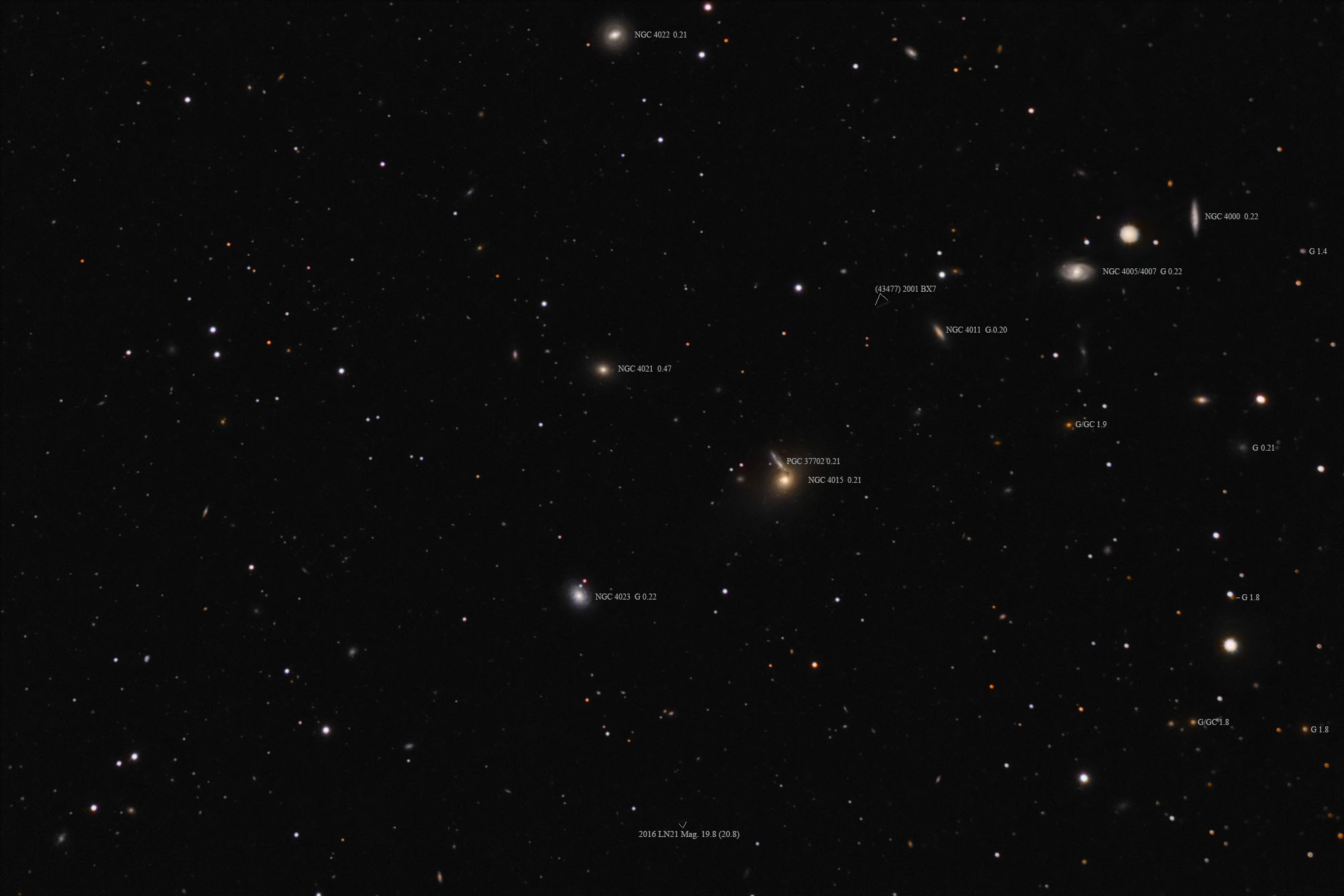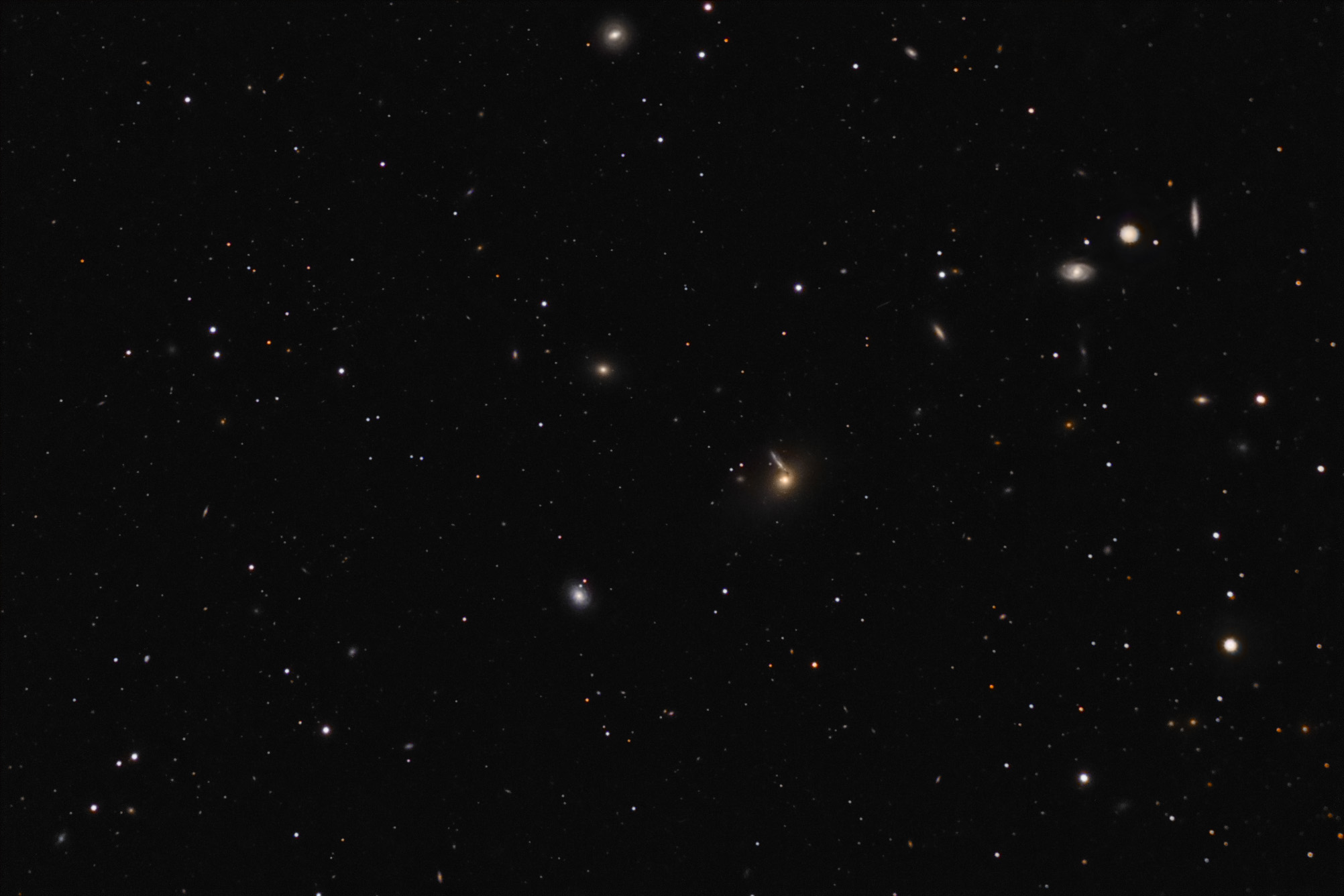| Description | Images |
Object name: ARP138Designation(s): ARP138, NGC4015, PGC37702, NGC4000, NGC4005, NGC4007, NGC4011, NGC4021, NGC4022, NGC4023, Arp 138, NGC 4015, is a pair of galaxies in Coma Berenices about 210 million light-years away. It is right on the border with Leo. In fact, the right 25% of my image is in Leo. Arp put this pair in his category Elliptical and elliptical-like galaxies: Material emanating from elliptical galaxies. His comment reads: "Absorption leads directly into E galaxy." I presume this refers to the dark cloud off the end of the spiral galaxy's tip. It's hard to tell if it is coming from the spiral or the elliptical. Arp apparently considers it coming from the elliptical or appearing to at least by the category it put it in. Since the elliptical shows no other signs of dust and spirals are often very dusty I'd suspect the spiral as being the more likely source of the dust. The redshifts of the galaxies are virtually the same so no help there. Related Designation(s):2MASS J11575702+2508387, 2MASS J11575703+2508399, 2MASS J11581016+2507200, 2MASS J11582543+2505516, 2MASS J11584319+2502376, 2MASS J11590102+2513220, 2MASS J11590259+2504596, 2MASS J11590547+2459206, 2MASX J11575699+2508402, 2MASX J11581014+2507199, 2MASX J11582545+2505521, 2MASX J11590100+2513216, 2MASX J11590257+2504596, 2MASX J11590546+2459206, 2MASXi J1157569+250840, 2MASXi J1158101+250720, 2MASXi J1158254+250551, 2MASXi J1158432+250238, 2MASXi J1159010+251322, 2MASXi J1159025+250459, 2MASXi J1159054+245920, 2MFGC 09404, ARK 339, ARP 138, ARP 138 NED02, ARP138, ASK 664936.0, ASK 664945.0, ASK 664971.0, ASK 664998.0, ASK 665000.0, ASK 665005.0, CGCG 1155.4+2525, CGCG 1155.6+2524, CGCG 1155.8+2523, CGCG 1156.1+2519, CGCG 1156.1+2519 NED02, CGCG 1156.4+2522, CGCG 1156.4+2530, CGCG 1156.5+2516, CGCG 127-118, CGCG 127-120, CGCG 127-121, CGCG 127-122, CGCG 127-122 NED02, CGCG 127-124, CGCG 127-125, CGCG 127-127, ECO 03212, ECO 03217, ECO 03228, ECO 05801, ECO 05802, EON J179.488+25.144, GALEXASC J115757.06+250838.3 , GALEXASC J115825.48+250551.0 , GALEXASC J115900.99+251321.7 , GALEXASC J115902.53+250457.9 , GALEXASC J115905.45+245920.1 , HDCE 0685 NED004, HDCE 0685 NED007, IRAS 11554+2524, IRAS F11554+2524, IRAS F11562+2518, ISOSS J11580+2508, KPG 314, KPG 314B, LCSB L0484O, LDCE 0854 NED005, LDCE 0854 NED008, LGG 261:[G93] 002, LGG 261:[G93] 004, LGG 261:[G93] 005, MAPS-NGP O_376_0636792, MAPS-NGP O_376_0794725, MAPS-NGP O_376_0799182, MCG +04-28-103, MCG +04-28-107, MCG +04-28-110, MCG +04-28-111, MCG +04-28-112, MCG +04-28-113, NGC 4000, NGC 4005, NGC 4007, NGC 4011, NGC 4015, NGC 4015 NED02, NGC 4021, NGC 4022, NGC 4023, NGC4000, NGC4005, NGC4007, NGC4011, NGC4015, NGC4021, NGC4022, NGC4023, NPM1G +25.0271, NSA 119537, NSA 119539, NSA 119545, NSA 119553, NSA 160846, NSA 160848, NVSS J115810+250719, PGC 037643, PGC 037661, PGC 037674, PGC 037702, PGC 037729, PGC 037730, PGC 037732, PGC37702, SDSS J115756.98+250838.7, SDSS J115756.98+250838.9, SDSS J115810.16+250720.0, SDSS J115810.16+250720.1, SDSS J115825.42+250551.5, SDSS J115825.43+250551.5, SDSS J115901.01+251322.0, SDSS J115901.01+251322.1, SDSS J115902.58+250459.5, SDSS J115902.59+250459.5, SDSS J115905.46+245920.2, SDSS J115905.47+245920.2, SDSS-g-fon-1341, SDSS-i-fon-1251, SDSS-r-fon-1321, UGC 06949, UGC 06952, UGC 06965, UGC 06965 NED02, UGC 06975, UGC 06977, USGC U437 NED02, USGC U437 NED05, USGC U437 NED06, UZC J115757.0+250839, UZC J115810.2+250720, UZC J115901.0+251322, UZC J115902.6+250500, UZC J115905.5+245920, VV 216, VV 216b, WBL 368-006, WBL 368-007, WBL 368-008, WBL 368-010, WBL 368-011, WBL 368-012, WBL 368-013, [DZ2015] 685-03, [DZ2015] 685-05, [DZ2015] 685-06, [M98j] 150 NED03, [M98j] 150 NED04, [M98j] 150 NED05, [SLK2004] 0647, [TTL2012] 338756, [TTL2012] 338764, [TTL2012] 339131, [TTL2012] 339918, [TTL2012] 339920, [TTL2012] 340385, |


